Search the Special Collections and Archives Portal
Search Results
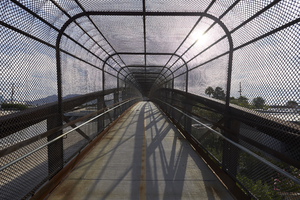
Interior of Bridge crossing Lamb Boulevard south of East Sahara Avenue, looking east, Las Vegas, Nevada: digital photograph
Date
2017-09-26
Archival Collection
Description
Inside of a bridge that is part of the Flamingo Arroyo Trail system as it crosses Lamb Boulevard south of East Sahara Avenue.
Image
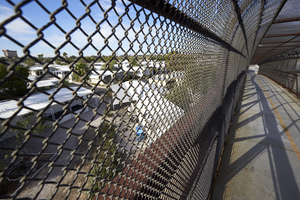
The view from a bridge crossing Lamb Boulevard south of East Sahara Avenue, looking southwest, Las Vegas, Nevada: digital photograph
Date
2017-09-26
Archival Collection
Description
A bridge that is part of the Flamingo Arroyo Trail system rises above a mobile home park as it crosses Lamb Boulevard south of East Sahara Avenue.
Image
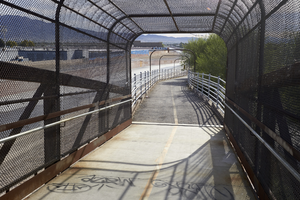
Bridge connecting to a path east of Lamb Boulevard south of East Sahara Avenue, looking east, Las Vegas, Nevada: digital photograph
Date
2017-09-26
Archival Collection
Description
A bridge that is part of the Flamingo Arroyo Trail system leads to a path on the east side of Lamb Boulevard south of East Sahara Avenue.
Image
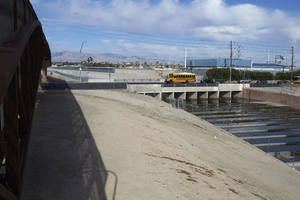
Bridge and Flamingo Wash cross Lamb Boulevard south of East Sahara Avenue, looking west, Las Vegas, Nevada: digital photograph
Date
2017-09-26
Archival Collection
Description
A bridge that is part of the Flamingo Arroyo Trail system parallels the Flamingo Wash as they cross Lamb Boulevard south of East Sahara Avenue.
Image
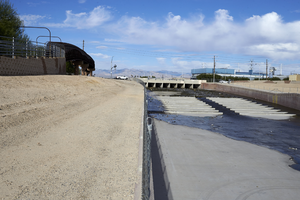
Bridge and Flamingo Wash cross Lamb Boulevard south of East Sahara Avenue, looking west, Las Vegas, Nevada: digital photograph
Date
2017-09-26
Archival Collection
Description
A bridge that is part of the Flamingo Arroyo Trail system parallels the Flamingo Wash crosses Lamb Boulevard south of East Sahara Avenue.
Image
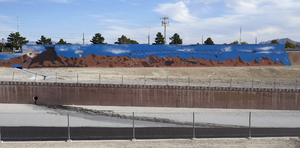
Mural along Flamingo Wash near Lamb and East Sahara Avenue, Las Vegas, Nevada: digital photograph
Date
2017-09-26
Archival Collection
Description
A mural is painted on a wall along the Flamingo Wash and Flamingo Arroyo Trial system off Lamb Boulevard south of East Sahara Avenue.
Image
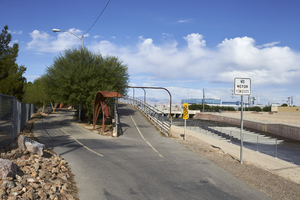
Flamingo Arroyo Trail system at Lamb Boulevard south of East Sahara Avenue, looking west, Las Vegas, Nevada: digital photograph
Date
2017-09-26
Archival Collection
Description
Flamingo Arroyo Trail system paths lead to a bridge as a way of crossing Lamb Boulevard south of East Sahara Avenue.
Image
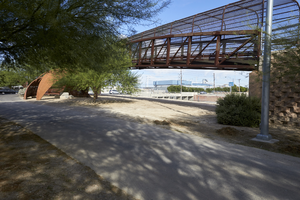
Flamingo Arroyo Trail system at Lamb Boulevard south of East Sahara Avenue, looking northwest, Las Vegas, Nevada: digital photograph
Date
2017-09-26
Archival Collection
Description
A bridge that is part of the Flamingo Arroyo Trail system parallels the Flamingo Wash near Lamb Boulevard south of East Sahara Avenue.
Image

Book of Mormon left at Wayside structure, looking east, Las Vegas, Nevada: digital photograph
Date
2017-09-26
Archival Collection
Description
A book of Mormon sits atop stone seating under the wayside station structure that is part of the Flamingo Arroyo Trail system near Lamb Boulevard south of East Sahara Avenue.
Image

Flamingo Arroyo Trail wayside structure near Lamb Boulevard south of East Sahara Avenue, looking north, Las Vegas, Nevada: digital photograph
Date
2017-09-26
Archival Collection
Description
A wayside station structure that is part of the Flamingo Arroyo Trail system is seen near Lamb Boulevard south of East Sahara Avenue.
Image
Pagination
Refine my results
Content Type
Creator or Contributor
Subject
Archival Collection
Digital Project
Resource Type
Year
Material Type
Place
Language
Records Classification
